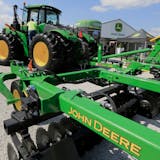Ellorie Jacobs loves everything Barbie.
"The dolls are super fun to play with, and it's about girl power," the 9-year-old from Lakeville said during lunch with her mom recently at the Malibu Barbie Cafe at Mall of America.
The blockbuster movie released in July has boosted California toymaker Mattel's Barbie brand. And while it's been a stalwart on toy store shelves for decades, there's undoubtedly a new fervor around the doll and anything related this holiday season.
Barbie sales jumped 25% for the July-August combined months vs. the same two-month period a year ago, according to Circana. It was the No. 1 doll globally in the third quarter (July through September), per Circana.
The buzz has continued into the colder months. As one example: The Toy Insider's Hot 20 list includes the Barbie Dreamhouse Playset for 3- to 4-year-olds.
"It's absolutely good for Mattel because the number of brands that have existed for 60 years or more and continue to be reinvented is very small," said Chris Byrne, a toy consultant behind toyguy.com. "G.I. Joe is five years younger but doesn't have the cultural cache."
Mattel co-founder Ruth Handler created Barbie — quintessentially recognized as a blonde-haired, blue-eyed, unrealistically proportioned adult woman — after watching her daughter Barbara play with paper dolls and deciding girls would have more fun with three-dimensional ones, according to the National Toy Hall of Fame. Barbie was an immediate hit in 1959.
The doll has evolved culturally and professionally after feminists criticized early Barbies for creating impractical physical standards for women and focusing only on fashion. Now there are Barbies of all sizes, hair colors, races and genders. Dolls come in enough variations to connect with any child, and there are plenty of accompanying accessories and merchandise, from the Barbie Dreamhouse to branded makeup to pop-up restaurants such as the Malibu Barbie Cafe.



